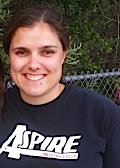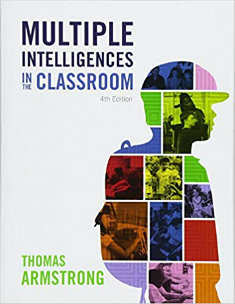Strategies for Building on Student Strengths
Multiple Intelligences in the Classroom
By Thomas Armstrong
(ASCD, 2018 – Learn more)

Whether Albert Einstein actually wrote this, the point is well taken: “Everybody is a genius. But if you judge a fish by its ability to climb a tree, it will live its whole life believing that it is stupid.”
While many educators could conjure in their mind the image of a student who might embody this quote – a student who thinks they are not good at school – many teachers struggle to know exactly how to help every kid see their own genius. In the fourth edition of his book Multiple Intelligences in the Classroom, Dr. Thomas Armstrong wants to help you stop struggling.

Translating theory into practice
The theory is that there are eight basic intelligences: linguistic, logical-mathematical, spatial, bodily-kinesthetic, musical, interpersonal, intrapersonal, and naturalistic. Armstrong takes those academic terms and adapts them to be more practical for the classroom, respectively becoming:
- word smart
- number/logic smart
- picture smart
- body smart
- music smart
- people smart
- self smart, and
- nature smart.
If you’re like me, as you read that list you could think of a student (or two) who embodied each of those intelligence types. Throughout this book, a reader will find countless ideas for incorporating the different intelligence types into everyday learning.
This book is less than 250 pages long, but it’s full of ideas on ways to help students who not only show a propensity for certain intelligence types, but to also help nurture every intelligence type within each student. The book is nothing if not thorough. The chapters lay out the underlying theory, ways to introduce the concept to students, ideas to develop curriculum using Multiple Intelligence (MI) Theory, teaching strategies, classroom environments, assessment, special education, and personalization, among other things. Finally, there is a chapter that addresses criticisms of the theory and does a fair job of refuting the negative pushback.
Educators looking for practical ways to plan lessons using MI will find just that in chapters 5 and 6. Armstrong writes: “Essentially, MI theory offers a means of building daily lesson plans, weekly units, yearlong themes, and other programs in such a way that all students can have their strongest intelligences addressed at least part of the time,” (pg. 62).
He proceeds to walk the reader through a planning experience and provides a guide as well as a list of techniques for teachers to consider when writing plans.
Identifying and building students’ strengths
Something I think any educator would appreciate about this book is the ease with which any of these activities could be used in the classroom once students are aware of their own multiple intelligences. Moving forward, if we are to focus on the strengths of our students, this book is a resource worth its weight in gold for all that it offers in that arena. After a self-inventory, students will be able to see where their strengths are, and where they can build more skills.
Teachers can then use this information to create curriculum and other activities that will play to the strengths of their students. For example, offered in this book is a sample lesson on how to teach the difference between the four most common punctuation marks, using all eight intelligence types (pg. 66). There are lists and tables dedicated solely to teaching strategies that use various intelligence types.
There are chapters dedicated to the classroom environment and its role in multiple intelligences, as well as classroom management ideas. Something that seems very valuable to the skeptical educator is the chapter on assessment. Many of us face the necessary evil that is standardized testing, but this chapter makes the case for things like portfolios which allow a teacher to assess student learning through a more realistic lens. The theory of multiple intelligences might lend itself especially well to project based learning.
Just right for faculty PD book clubs
This title is a great choice for any faculty book club focused on professional development. As we continue to prepare students for college and careers in the 21st century, skills like those found within these pages will be essential to for kids to learn. The author does a great job of explaining why it is important to not only start with the strengths of each individual student but also avoid pigeonholing students or leading them to think that a particular intelligence is their only intelligence. Instead, Armstrong argues, expose students to all intelligence types and help them develop them in balance.
Once you have read this book through one time, you can continue to go back through and find the exact resource, strategy, activity, or assessment tool you need. There are so many ideas in these pages that it is impossible not to go back and skim each chapter again. The information is worth the effort!
Responses to criticisms of MI theory
Skeptical educators may find their concerns put to rest toward the end of the book when criticisms of Gardner’s theories are addressed. Armstrong proposes that most of the published criticisms are from individuals not actively working in classrooms or education, but from journalists and academics (specifically cognitive psychologists). Indeed, many educators have praised the theory as a great contribution to American education (pg. 196).
Everything a teacher needs to get started with implementing the theory of multiple intelligences is offered within the book. Easy changes can be made to any classroom or teacher’s instruction the day after reading Armstrong’s work. So, if you’re like me and always trying to learn more about helping all your students, pick up a copy, read it through, and go help kids be the best versions of themselves.
Michelle Voelker is a 7th grade English and World History teacher at an urban school in Sacramento, CA. This past summer she was a fellow with Area 3 Writing Project, a branch of the National Writing Project, in their Summer Institute and is now a teacher leader, providing workshops on writing in the history classroom. Before becoming a teacher, Michelle was an AmeriCorps member for a program that provided reading intervention on Title I elementary campuses. Since then, she has worked to make sure that every kid has access to literacy and becomes a lifelong reader.


































